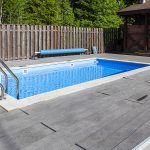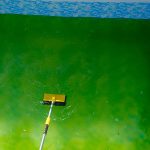The Importance of Proper Water Chemistry
There is so much more to swimming pools than meets the eye. And in order for your pool water to appear clear and clean to the eye, proper water chemistry needs to be maintained. Maintaining proper water chemistry is an ongoing process as the water chemistry can be easily affected by so many things that get into the pool including, rain, environmental debris, bathers, and other chemicals.
Chemical Readings
There are a multitude of things that one can test for at the swimming pool. The five main readings taken on a weekly basis at your pool include sanitizer, pH, Alkalinity, Calcium Hardness, and Cyanuric Acid. The sanitizers primarily used are chlorine or bromine which does the sanitizing and oxidizing of your pool water. pH and alkalinity are closely related with alkalinity helping to maintain your pH levels to create a comfortable environment for pool, equipment, and bathers. Calcium hardness helps the water so that it is not too corrosive or aggressive for the water environment. Cyanuric acid is a stabilizer which is essentially a sunscreen for chlorine protecting it against depletion from UV rays. Bromine cannot be stabilized so it is only recommended for indoor pools and spas, especially.
Chemical Dosing
Proper chemical dosing is key in maintaining proper water chemistry. This involves mathematically computing the correct amount needed to either raise or lower a certain chemical reading in your pool. You don’t want to haphazardly dump a random amount of chemical in your pool. This can do more damage than good, and also wastes money by adding chemicals that may not be needed or too much of another chemical that will need further adjustment. This also wastes time with the need to correct the overdosing.
Chemical Testing
Accurate water testing is essential for swimming pools as the environment is continuously changing. Even a slight breeze can change your chemical parameters. Frequent testing can help to prevent your pool from going out of range and have your condition deteriorate quickly. Performing tests properly are key to getting accurate readings. Some general rules for proper testing include:
- Follow directions inside the test kit carefully.
- Do not touch the inside or top of the vial, its cap, any testing reagents, or the colored pads on the test strip. This will falsely contaminate the test sample.
- Choose a testing location away from an inlet that returns water from the filter to the pool. Take water sample 12″-18″ below the surface water level.
- Rinse the vial thoroughly with pool water between tests.
- Position yourself so the sun is behind you and read the results by holding a white card behind the vial (without creating a shadow).
- Rinse the vial thoroughly and dry with a paper towel. Any reagent that remains inside the vial may stain the plastic and give false future readings.
Chemical Reaction
So, when you maintain proper chemicals readings, perform proper chemical dosing, and record proper chemical testing, your pool’s reaction will be happy and ready for a great day of swimming!






